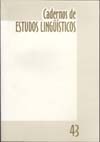Resumen
Um modelo de osciladores acoplados da produção do ritmo da fala é apresentado, modelo este capaz de reproduzir via simulação os padrões de duração de unidades do tamanho da sílaba em português brasileiro, incluindo casos de encontro acentual. Para tanto, os parâmetros do modelo são otimizados com relação a frases naturais e manipulados convenientemente a fim de reproduzir os dados comportamentais. Ao comparar padrões de duração para três tipos de unidades prosódicas mínimas (sílaba, GIPC e rima) em condição ou não de choque acentual, não se encontrou evidência clara para o deslocamento acentual: os padrões nas duas condições exibem um aumento da duração das unidades em questão em direção ao acento frasal à direita. Discute-se uma possível relação do deslocamento acentual com a colocação do pitch accent bem como com a alternância de proeminências ao longo do enunciado.Citas
ALBANO, E. C. (2001). O Gesto e suas Bordas: Esboço de Fonologia Acústico-Articulatória do Português Brasileiro. Mercado de Letras: Campinas, Brazil.
ALLEN, G.D. (1972). The location of rhythmic stress beats in English I & II. Language & Speech. 15: 72-100, 179-195.
BAILLY, G. (1986). Un modèle de congruence relationnel pour la synthèse de la prosodie du français. Actes des 15es Journées d’ Étude sur la Parole. Aix-en-Provence, France. pp. 75-78.
BARBOSA, P.A. (1996). At least two macrorhythmic units are necessary for modeling Brazilian Portuguese duration: emphasis on segmental duration generation. Cadernos de Estudos Lingüísticos. 31: 33-53.
BARBOSA, P.A. (2000). “Syllable-Timing in Brazilian Portuguese”: uma Crítica a Roy Major. D.E.L.T.A., 16 (2): 369-402.
BARBOSA, P.A. (2001). Generating Duration from a Cognitively Plausible Model of Rhythm Production. Proceedings of the Eurospeech 2001. Ålborg, Denmark. v. 2, pp. 967-970.
BARBOSA, P.A. (2002) Explaining Cross-Linguistic Rhythmic Variability via a Coupled-Oscillator Model of Rhythm Production. In: Bernard Bel & Isabelle Marlien (eds.) Proceedings of the Speech Prosody 2002 Conference. 11-13 April, Aix-en-Provence, France. pp. 163-166.
BARBOSA, P.A. & MADUREIRA, S. (1999). Toward a hierarchical model of rhythm production: evidence from phrase stress domains in Brazilian Portuguese. Proceedings of the XIVth International Congress of Phonetic Sciences. v. 1. pp. 297-300.
BROWMAN, C.P. & GOLDSTEIN, L. (1986). Towards an articulatory phonology. Phonology Yearbook. 3: 219252.
BROWMAN, C.P. (1989). Articulatory Gestures as Phonological Units. Phonology. 6: 201-251.
BROWMAN, C.P. (1990). Tiers in Articulatory Phonology with some Implications for Casual Speech. In: KINGSTON, J.; BECKMAN, M. E. (eds.) Papers in Laboratory Phonology I, Cambridge: Cambridge University Press. pp. 341-376.
CONNELL, B.; ARVANITI, A., eds. (1995). Phonology and Phonetic Evidence: Papers in Laboratory Phonology IV. Cambridge: Cambridge University Press.
DOGIL, G.; BRAUN, G. (1988). The PIVOT model of speech parsing. Wien: Verlag.
FUJIMURA, O. (1995). Prosodic organization of speech based on syllables: the C/D model. Proceedings of the XIIIth International Congress of Phonetic Sciences. v. 3,. pp. 10-17.
GRABE, E.; WARREN, P. (1995). Stress Shift: do speakers do it or do listeners hear it? In: CONNELL, B. & ARVANITI, A. pp. 95-110.
JANKER, P. (1995). On the influence of the internal structure of a syllable on the P-center perception. Proceedings of the XIIIth International Congress of Phonetic Sciences. v. 2. pp. 510-513.
LEHISTE, I, (1978). Temporal organization and prosody. Perceptual aspects. Joint Meeting of A.S.A. and A.S.J. v.1. Honolulu. pp. 1-17.
LIBERMAN, M. & PRINCE, A. (1983). On stress and linguistic rhythm. Linguistic Inquiry. 8 (2): 249-336.
MASSINI, G., (1991). A Duração no estudo do acento e do ritmo em português. Master’s thesis. Campinas: University of Campinas.
MCAULEY, J.D. (1995). Perception of Time as Phase: Toward an Adaptative-Oscillator Model of Rhythmic Pattern Processing. Unpublished PhD dissertation, Indiana University, USA.
MORTON, J.; MARCUS, S. & FRANKISH, C. (1976). Perceptual centers (p-centers). Psychological revue. 83 (5): 405-408.
O’DELL, M. & NIEMINEN, T. (1999). Coupled Oscillator Model of Speech Rhythm. Proceedings of the XIVth International Congress of Phonetic Sciences. San Francisco, USA. v. 2. pp. 1075-1078.
O’DELL, M. (2001). Speech Rhythms as Cyclical Activity. In: S. OJALA; J. TUOMAINEN (eds.). 21. Fonetiikan päivät Turku 4.-5.1.2001, Publications of the Department of Finnish and General Linguistics of the University of Turku. 67. pp. 159-168.
ÖHMAN, S. (1966). Coarticulation in VCV utterances: spectrographic measurements. J. Acoustic. Soc. Am. 39: 151-168.
POMPINO-MARSCHALL, B. (1989). On the psychoacoustic nature of the p-center phenomenon. Journal of Phonetics. 17: 175-192.
SHATTUCK-HUFNAGEL, S. (1995). The importance of prosodic transcription in empirical approaches to “stress shift” versus “early accent”: comments on Grabe and Warren, and Vogel, Bunnell and Hoskins. In: CONNELL, B.; ARVANITI, A. (eds.). pp. 128-140.
SHATTUCK-HUFNAGEL, S.; OSTENDORF, M. & ROSS, K. (1994). Stress shift and early pitch accent placement in lexical items in American English. Journal of Phonetics. 22: 357-388.
TESNIÈRE, L. (1965). Éléments de syntaxe structurale. Paris: Klincksieck.
VAISSIÈRE, J. (1983). Language-independent prosodic features. In: CUTLER, A.; LADD, D.R. (eds.) Prosody: models and measurements. Berlin: Springer-Verlag. pp. 53-66.
VOGEL, I.; BUNNELL, H.T. & HOSKINS, S. (1995). The Phonology and Phonetics of the Rhythm Rule. In: CONNELL, B.; ARVANITI, A. pp. 111-127.
Se otorgan a la Revista CADERNOS DE ESTUDOS LINGÜÍSTICOS todos los derechos de autor relativos a los trabajos publicados. No se devolverán los originales. En virtud de su aparición en esta revista de acceso abierto, los artículos son de uso gratuito, con la debida atribución, en aplicaciones educativas y no comerciales.

